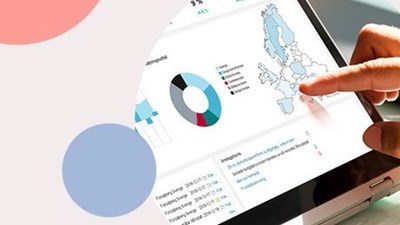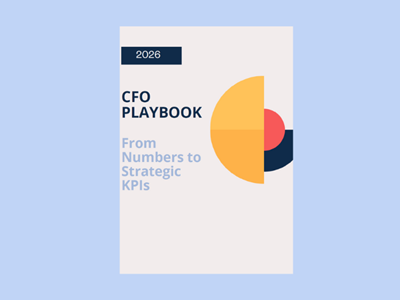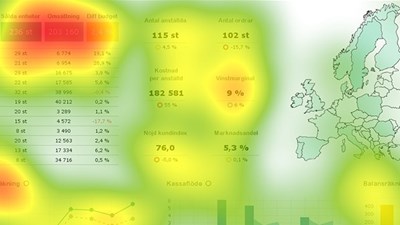
How xP&A (Extended Planning and Analysis) Transforms Business Planning
The pace and complexity of business have never been greater. Organisations are wrestling with rapid technological change, geopolitical uncertainty and shifting market dynamics. To overcome these challenges, many are turning to extended planning and analysis (xP&A). This is a transformative approach that is redefining how businesses plan, analyse and execute their strategies.
Extended planning and analysis enable a new era of agility, collaboration and data-driven decision-making. This blog will discuss the approach that moves beyond the traditional boundaries of finance.
What Is xP&A (Extended Planning & Analysis)?
The xP&A definition is rooted in the evolution of financial planning and analysis (FP&A). While FP&A has long been the backbone of financial forecasting, budgeting and reporting, its scope has largely been confined to the finance function. xP&A, on the other hand, expands its focus to include all areas of an organisation that influence business outcomes, including human resources, sales, marketing, operations and IT.
The goal is to break down departmental silos and foster a culture of cross-functional collaboration. It ensures that planning is not just a finance-driven exercise but a holistic, organisation-wide process.
At its core, extended planning and analysis integrates financial and operational data, allowing for unified planning, budgeting and forecasting. It's a way to ensure that plans and metrics of every department are aligned with the overall strategic objectives of the business. This approach offers an overall view of the business performance by using advanced analytics, automation and real-time data. At the same time, this helps leaders make quick and confident decisions.
xP&A vs. FP&A: What Is the Difference?
There is a significant difference in the xP&A vs FP&A comparison. The traditional FP&A focuses on financial data, offering forecasts and budgets based on historical trends and current financial metrics. It's an effective method for managing the books. Still, it's an approach that can be limited by the narrow focus and reliance on static and periodic planning cycles.
On the other hand, we have xP&A, which extends these capabilities. It integrates non-financial data and operational insights across the entire organisation. This approach allows continuous and real-time planning that reflects the dynamic nature of modern businesses.
Extended planning and analysis enable continuously updated forecasts and scenario planning as conditions change. This is not the case with FP&A's approach, which can produce quarterly forecasts. The result of this difference is improved alignment between departments, greater agility and an organisation that quickly responds to emerging risks and opportunities.
Core xP&A Capabilities
Would you use outdated data or forward it to someone on your team to make decisions that affect your business's competitiveness? Surprisingly, many companies do. They operate without a complete data management system that enables all managers to see an accurate and complete business picture.
xP&A helps to optimise a company’s full potential across all essential functions: finance, human resources, sales, marketing, operations, supply chain, IT and R&D. It’s an effective way of ensuring companies are in tune with their data to capitalise on every business opportunity.
1. Real-time Data for Insightful Analysis
One of the capabilities of xP&A is its ability to deliver real-time data and insights. All managers integrate data from multiple sources, like plans, forecasts, non-financial and financial data, into a real-time connected system. The resulting data pool enables groups, cost centres, departments, divisions or subsidiaries to work together remotely or in any office for prompt decision-making. They can create financial and operational plans, such as rolling forecasts from up-to-the-minute data.
Real-time access empowers decision-makers to move past their gut instinct and base their actions on accurate and current information. Today, this is easily done with the introduction of AI and automation. The xP&A systems become increasingly skilled at identifying patterns, flagging anomalies, and offering predictive insights to help organisations stay ahead of the curve.
2. Performance Management of All Company Data
Extended planning and analysis is not just about collecting data, but also about using it to drive performance. Using consolidating metrics that are extracted from operations, finance, sales, HR and other functions, it can provide an overview of the organisational performance.
Leaders are able to see how different parts of the business contribute to a certain strategic goal. Since teams have a clear visibility into their targets and progress, this approach also supports accountability.
3. Integrated Supply Chain and Financial Planning
Most businesses have experienced supply chain issues. xP&A has the ability to make the delivery of goods and services from supplier to customer more efficient. Organisations can easily optimise resource allocation and reduce waste. All that's needed is to align sales forecasts, production schedules and inventory levels with financial budgets. This can sometimes be a problem.
If we drill down to more basic but fundamental business activities, the findings are alarming. While finance teams often attribute manual data entry to critical errors, the majority of finance professionals still rely on outdated tools. Many may not know that, years ago, a spreadsheet copy-paste error cost JP Morgan billions in trading losses. A faulty calculation also led to a £18.5 million budget shortfall.
This is why there must be a better connection between accurate data delivery and insightful analysis. Companies must act with current figures efficiently and spend more time calculating good business decisions.
Mercur Solutions surveyed its customers and found that xP&A allowed them to do precisely that. Since switching to its xP&A system, Mercur Business Control, 94% say they now have more time for analysis and monitoring.
The outcome is that all these companies can dive deep into their current supply chain or other operational and financial data. Their teams can create graphics to illustrate problems and timely solutions.
Key Benefits of xP&A
Does switching to xP&A require a significant change in work practices? Not at all. Users continue to input data, and the solution makes it available to all company managers, offering the following benefits as needed.
Agility
Agility is perhaps the most compelling benefit of xP&A, enabling businesses to adapt and respond quickly to changing market conditions. Organisations can adjust their strategies and make informed decisions without delays.
Enhanced Visibility
It delivers a level of transparency that was previously unattainable. By providing a single source of truth for all planning and performance data, it eliminates the blind spots and inconsistencies that can arise when departments operate in isolation.
With a centralised platform, all managers have a holistic view of the entire organisation’s performance. This enables better tracking of key performance indicators (KPIs), identifying trends, and spotting potential issues early on.
Scalability
As businesses grow and evolve, their planning and analysis needs become more complex. With an integrated platform, organisations can easily add or modify functionalities to support their expanding requirements.
Businesses will become even more data-driven. Companies must connect optimum delivery and current business information management to maintain or gain a competitive edge.
How Mercur Business Control Powers xP&A
Mercur Business Control creates customer value through improved financial and operational performance, as well as greater efficiency. Mercur Business Control provides solutions for:
Corporate performance management and business intelligence
Budgeting and forecasting
Reporting and analysis
KPI management
Enterprise Resource Planning (ERP) integration, and more.
Hellmann Worldwide Logistics was an early adopter of Mercur Business Control.
Almost 500 of Hellmann’s management, financial controllers and business managers across 65 countries use Mercur Business Control to input, share and analyse company data in real time.
Is Your Organisation Ready for xP&A?
The shift from traditional FP&A to extended planning and analysis is more than just a technological upgrade. It represents a fundamental change in how organisations approach business planning.
In an environment defined by uncertainty and rapid change, xP&A offers the solution needed to thrive. The benefits of xP&A are clear: faster, more informed decisions, better alignment across departments and improved resilience in the face of disruption.
The question for business leaders is not whether to adopt this approach, but how quickly they can make the transition. Organisations that embrace extended planning and analysis will be better positioned to seize opportunities, manage risks and deliver sustained performance. The time to act is now, because in today’s world, standing still is not an option.
Do you want to know how we can assist you with xP&A?
Please fill out the form, and we will contact you to provide more information!
 Blog
BlogSpreadsheets Risk the Future of the Business
Spreadsheets often start as just a list for storing information and there is minimal process documentation, support or maintenance for these worksheets. Despite the fact that desktop applications such as Microsoft Office are included in the standard configuration of users' PCs, very little formal training is ever given to spreadsheet users.
 Blog
BlogManagement Reporting Guide: Definition and Tips
Management reporting helps you see what’s really happening in your business. In this guide, we’ll explain what managerial reporting looks like and share practical tips.
 Blog
BlogThe Collaborative, Smarter Budget
In many organisations manual budgeting processes over-burden staff and create masses of data which overwhelms department heads and stops them seeing the bigger picture.
 Blog
BlogTop-Down vs Bottom-Up Budgeting
Budgeting aligns resources with strategic goals, and there are two primary approaches: top-down and bottom-up. Which method wroks best?
 Blog
BlogSave time and create a successful budget process
If you’re working in a large organization, you’re probably aware of how time-consuming the budget process can be. In this article we’ll give you tips on how to save time and still create a successful budget process
 Blog
BlogTop 7 Manager KPIs for Financial and Operational Success
In today's post we'll break down why KPIs matter, which ones offer the most insight for finance and executive teams and how to ensure they're actually driving results.
 Blog
BlogFive tips for a successful budget process!
How can you make your budget process more successful and maximise the effort that was invested in creating it? Of course, there are many factors to consider but we’ve chosen to highlight five key areas that will enable and help you create a smoother, value-creating and collaborative budget process.
 Blog
BlogThe Powerhouse of EPM Tools
A business’s success heavily relies on having a strong strategy. However, what's even more important is implementing that strategy while tracking and measuring the performance. This can easily be done by investing in enterprise performance management (EPM) software.
 Blog
BlogAI in corporate budgeting
Artificial Intelligence (AI) can support decision making in key areas such as budgeting, capital allocation and even corporate strategy and as a result, it is increasingly being deployed in corporate performance management tools (CPM).
 Blog
BlogZero-Based vs. Incremental Budgeting
Budgeting sits at the heart of sound financial management. This is why choosing the right technique is crucial for CFOs – it shapes resource allocation, cost control and strategic agility. Incremental and zero-based budgeting are two leading methods that offer distinct approaches.
 Blog
BlogFP&A Trends Shaping Financial Planning in 2025
Many organisations cope with fragmented planning and data quality issues, which slow down their forecasting cycles. This forces organisations to take practical steps to turn ambition into execution.
 Blog
BlogVariance Analysis: A Comprehensive Guide
Senior executives are demanding more detail in their management reports. The amount of data available to finance departments has exploded and decision makers see this as an opportunity to get more insight into how the business is performing.
 Blog
BlogHow To Create a Successful Budgeting Process
When done well, budgeting helps organisations stay financially on course, even when things don’t go exactly as planned. Learn how to keep things on track so you avoid surprises and stay focused on your goals.
 Blog
BlogAI and Machine Learning, what is it, and why is it important for the future?
Artificial Intelligence and Machine Learning, what is it, and what is the difference?
 Blog
BlogThe Hidden Cost of Data Silos
If you ever feel like your teams speak different languages when it comes to data, it is a classic symptom of data silos. The information gets stuck in one department, system or tool, making it difficult for anyone to see the full picture.
 Blog
BlogRolling Forecasts: Practical Steps, Benefits, and How to Get Started
Financial planning has changed. Traditional annual budgets can’t keep up with rapid shifts in the market, evolving customer needs, and internal performance dynamics. That’s why many finance teams are turning to a rolling forecast model.
 Blog
BlogHow can AI help CFOs make better decisions?
Artificial Intelligence (AI) has significant potential to enhance decision-making for Chief Financial Officers (CFOs) by providing data-driven insights, automating routine tasks, and enabling more accurate forecasts.
 Blog
BlogSpreadsheet Risk Management: Best Practices for 2025
Excel has long been a target for hackers; just one click on a malicious attachment can infect your entire network. So, how can you keep using spreadsheets while not sacrificing your safety?
 Blog
BlogWhy is our Excel-based budget always out of date?
Excel creates outdated budgets. Every time someone enters a figure, sends a file, or waits for another department to finish their section, your budget falls further behind reality.
 Blog
BlogBuild Long-Range Planning for Business Success
Discover how effective long-range planning aligns strategy, finance and operations for smarter decisions and sustainable growth.
 Blog
BlogAI in Financial Planning: Trends and Next Steps
Discover how finance teams are using AI to drive smarter planning, faster insights, and stronger business decisions.
 Blog
BlogInformed Business Decisions at Maximum Velocity
The ability to process information swiftly is essential. If your business can’t manage your data efficiently, your company’s financial performance will surely underperform. At Mercur we have developed our own database Veloxic which helps Financial Planning and Analysis.
 Blog
BlogScenario Planning - Better control during uncertain times
Uncertain times create the need for more frequent forecasts and time for analyzing and comparing different future scenarios. We give you 5 tips on how to simulate future scenarios using scenario planning
 Blog
BlogThe Business Benefits of Integrated Business Planning
This blog explores what IBP is and the typical IBP process. We highlight business benefits and how the right software can be a game-changer for your organisation.
 Blog
BlogBusiness Budgeting Software: How to Choose the Right One
Choosing budgeting software is partly a finance and partly a strategic decision. The right tool helps organisations organise planning cycles, adapt as the market changes and increase accountability across departments. But not every platform will be a good fit.
 Blog
BlogWhat is Corporate Performance Management? (CPM)
CPM, or Corporate Performance Management, is a process within corporate management aimed at measuring and optimizing the performance of an organization. CPM encompasses a range of activities, including budgeting, planning, forecasting, reporting, and analysis.
 Blog
BlogBudgeting in a modern world
Thirty years after its debut, Microsoft Excel is still the preferred tool for budgeting and planning projects. However, its popularity is declining, due in most part to the rise of technology and subscription-based pricing for a myriad of SaaS-based products.
 Blog
BlogHow do finance teams track KPIs across the entire organisation?
Learn how finance teams track KPIs across the entire organisation by consolidating data from multiple sources into a unified system like Mercur.
 Blog
BlogCFO Playbook - KPIs for 2026
The role of the CFO is changing fast. Today, the finance function is expected to deliver more than reports — it must drive direction, speed and profitability through clear, actionable KPIs. Learn more in this guide.
 Blog
Blog3‑Statement Model for Better Financial Forecasting
Financial forecasting is critical for any business that wants to adapt to change. But finance teams keep usingfragmented models and manual processes. The 3-statement financial model is the solution.
 Blog
BlogBalancing Profitability and Sustainability
Sustainability has become a central concern for organisations across the world — and the UK is no exception. This evolving landscape places new demands on financial reporting.
 Blog
BlogHow to succeed with your planning, budgeting, and forecasting process
We know it can be challenging to succeed with your planning, budgeting, and forecasting process. Therefore, we have gathered our best tips for you to succeed!
 Blog
BlogBetter Revenue Planning
Sales forecasting is the process of predicting future revenue based on past data and trends. Read the blog to learn the best methods to do it right.
 Blog
BlogAI in Finance as a Powerful Tool
In this post, we explore how AI is evolving from a theoretical concept into a valuable resource for decision-making. Get useful insights for finance teams at any stage, from early exploration to actively using AI-powered solutions.
 Blog
BlogHow Automated Reporting Will Transform FP&A in 2026
This article highlights the power of report automation, how to implement it in your business and explores any new opportunities for accurate financial analysis in the long run.
 Blog
BlogRisks with working in spreadsheets
Spreadsheets are an essential tool for all types of organisations and businesses rely on them heavily, particularly for financial computations. The most popular spreadsheet program globally is, of course, Microsoft Excel, it’s used by an estimated 750 million people.
 Blog
BlogFrom static budgets to agile financial management
Traditional budgeting has long been the cornerstone of financial planning in businesses. But today it can become more of a limitation than a strength. That’s where the concept of Beyond Budgeting comes in.
 Blog
BlogMastering Spreadsheets
Where many businesses start small, a simple spreadsheet can adequately perform the limited tasks required of it. As the company grows, your spreadsheets can get more complex and harder to manage, by which point it feels like it will be too difficult to move to a different reporting tool.
 Blog
BlogWhat Is FP&A? Definition, Purpose, and Best Practices
Without solid financial planning and analysis (FP&A), businesses operate in the dark. In this post we go deeper into the process of FP&A and why it’s important for businesses.
 Blog
BlogThe Role of the CFO: Top Priorities and Responsibilities
Today's finance leaders steer more than just budgets and reports. The digital transformation ramps up with the increase of corporate complexity, and so does the role of CFOs.
 Blog
BlogWhat is management reporting?
Management Reporting refers to the process of creating, analyzing, and presenting information about various aspects of an organization's performance to enable decision-makers to make well-informed decisions about the future.
 Blog
BlogHow to get accurate financial reports without waiting for month-end
You don't need to wait until month-end to see accurate financial reports. With modern financial systems you can access up-to-date reports whenever you need them.
 Blog
BlogBoost Report Readability, Engagement, and Decision-Making
In today’s fast-paced business environment, effective reports and dashboards are crucial for decision-making. Our user study using eye-tracking technology revealed seven key insights into what captures attention.
 Blog
BlogSpreadsheets are not Collaborative Tools
Spreadsheets were never designed for collaboration, yet they are the single most used program among teams and co-workers. They often start out as a quick document for storing, formatting or calculating information but evolve into important documents and are often the core records for an organisation.
 Blog
BlogWhat Is Planning, Budgeting and Forecasting?
Planning, budgeting and forecasting are rarely static. Shifts in the industry often require you to revisit assumptions, adjust targets and adopt new processes. Learn how to strengthen your approach and stay ahead of change.
 Blog
BlogBest Guide to Improve Your Revenue with Flexible Budgeting
Optimise your expenses with flexible budgeting, and learn how to adjust budget to reflect current business activities, market changes and cost fluctuations.
 Blog
BlogHow EPM Transforms Financial Planning and Forecasting
Struggling to keep plans aligned in a changing market? Discover how EPM helps finance teams move faster, stay accurate and lead with real-time insights.
 Blog
BlogCash Flow Forecasting
Inaccurate cash flow forecasting can be a costly mistake for companies. In today’s volatile market, relying on static annual budgets or manual spreadsheets leaves financial leaders without the agility to respond to uncertainty.
 Blog
BlogTop PowerBI Alternatives in 2025
Explore the top PowerBI alternatives for 2025. Discover how Mercur delivers integrated planning, budgeting and reporting without the high cost and complexity.
 Blog
BlogBusiness Intelligence Reporting For Finance Teams
The real challenge today isn’t collecting data, it’s making sense of it and fast. Organisations turn to business intelligence (BI) to convert raw data into insight.But how do you actually do it right?
 Blog
BlogHow to Effectively Budget with Driver-Based Forecasting
Traditional models of forecasting rely on historical data and beliefs. It uses techniques that identify patterns, which are simple to use. However, with these methods, there are some challenges because they are not dynamic with today’s market, and can’t effectively analyse complex data.
 Blog
BlogA practcial guide to scenario planning
Scenario planning gives you a clear, practical way to test assumptions, spot risks and opportunities, and make better strategic choices so your organisation stays resilient when conditions change.





















































